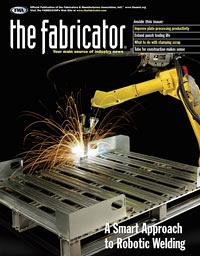Contributing Writer
- FMA
- The Fabricator
- FABTECH
- Canadian Metalworking
Categories
- Additive Manufacturing
- Aluminum Welding
- Arc Welding
- Assembly and Joining
- Automation and Robotics
- Bending and Forming
- Consumables
- Cutting and Weld Prep
- Electric Vehicles
- En Español
- Finishing
- Hydroforming
- Laser Cutting
- Laser Welding
- Machining
- Manufacturing Software
- Materials Handling
- Metals/Materials
- Oxyfuel Cutting
- Plasma Cutting
- Power Tools
- Punching and Other Holemaking
- Roll Forming
- Safety
- Sawing
- Shearing
- Shop Management
- Testing and Measuring
- Tube and Pipe Fabrication
- Tube and Pipe Production
- Waterjet Cutting
Industry Directory
Webcasts
Podcasts
FAB 40
Advertise
Subscribe
Account Login
Search
Is robotic welding right for you?
Making an informed decision
- By Tim Nacey
- November 15, 2001
- Article
- Automation and Robotics
 |
Recent shortages of trained labor, combined with advances in technology, present a convincing argument to introduce robotic weldingto many factory and job shop operations.
When a fabricating company already operating at its highest production capacity gets a bigger contract, it is faced head-on with the need to use existing manufacturing space and personnel more efficiently. The driving force behind the decision to turn to robotics comes when the company realizes it's impossible to get the required level of production from its existing plant using available personnel and technology resources.
As you ponder whether you want to, need to, or should incorporate robotics into your welding operation, consider the following questions.
What Comprises a Robotic Installation?
A robotic welding cell consists of machinery powered to make a series of repetitive subweldments that combine to form a weld joining metal to metal. An integrated arc welding system, in which equipment components are produced by one manufacturer to work together, consists of a power source, controller, and the robot itself.
Most often a company's first robotic installation is a progression from manual or semiautomatic welding. It also can be the next step in a fixed automation system. A system does not necessarily have to be all robotic. In some cases robotic, automated, and manual systems work in combination, depending on the task and a variety of other parameters, such as floor space, logistics, and objectives.
Fixed welding automation works best for high-volume, simple applications. Dedicated automation often is less expensive than robotics when producing simple, straight-line, or circular welds. A robotic system usually can handle more complex and changing paths.
However, the transition typically is from a manual (as opposed to automated) system to a robotic operation. What usually mandates the change is strong customer demand that requires a fabricator to turn out high volumes or produce complex shapes. In some cases manual and robotic systems can work well in concert, because certain welds are best made by hand.
Robots can perform repeat tasks consistently and with quality. Continual human supervision, instruction, and maintenance are vital to ensure these standards.
What Are the Costs and ROI?
Cost is a major consideration, and it is best understood when it's compared to the price of labor and resultant productivity. A robot typically should triple the productivity of a welder at similar cost to achieve a return on investment within a year.
Cost of equipment is coming down, and robots can be leased. Some programs allow leasing of robotic systems for 2-1/2 to 3 percent of value per month, or about 30 percent of value annually. In contrast to manual training programs that last eight to 10 weeks, a robotics training program lasts three to four days.
Are There Any Other Considerations?
Actually, there is a lot more to the decision than money. The final choice often is affected by emotion — typically apprehension and doubt from dealing with the unknown.
People assume that implementing robotics is a complex move and that employees will lose jobs. As in many arenas involving humans, there is tremendous comfort in the industry with the way things have always been done, sometimes accompanied by lack of information about new procedures.
Buying their first robot is a huge leap for many. Once it is in place and working, and people see how it fits into the existing operation, bringing in the second robot usually is a much easier decision.
The process, which can be daunting, is best considered as a series of steps, which can help dispel the emotional aspects of the issue.
What Metal Industries Are Best-suited for Welding Robotics?
The automotive industry, of course, is the original high-volume purchaser of robotic equipment. However, robotics use is increasing for arc welding operations in the construction and agricultural equipment industries that produce larger weldments, as well as in small job shops.
As the economics of robotics improves, more industrial categories are becoming involved in their use. In these industries — steel furniture, fitness equipment, and cabinetry — the systems chosen typically are pre-engineered rather than customized. Pre-engineered workcells offer the end user a choice of many configurations and the advantage of having all the necessary components preinstalled, including the robot, power source, controller, safety equipment, and material handling systems.
What Else Can a Robotic Welding System Do?
A new wave of programmable software monitors, controls, and has global access to real-time information, all of which permit timely corrective action as the need arises. Through data captured by a PC network, for instance, an operator can catch a bad part within moments instead of finding out at the end of the shift that the whole batch is defective.
Capabilities such as these can free companies to advance and take on new and larger customers, as well as give employees the opportunity to perform more diverse and complex tasks. Robotics, after all, requires someone to operate systems as well as perform ongoing supervision, inspection, and maintenance.
Careful Evaluation
Making the decision to use robotics is hardly an automatic process. Evaluating the situation carefully should help managers make an informed choice. No matter what is decided at this juncture, the process itself should help you to analyze and streamline the work ahead and prepare for the future.
About the Author
subscribe now

The Fabricator is North America's leading magazine for the metal forming and fabricating industry. The magazine delivers the news, technical articles, and case histories that enable fabricators to do their jobs more efficiently. The Fabricator has served the industry since 1970.
start your free subscription- Stay connected from anywhere

Easily access valuable industry resources now with full access to the digital edition of The Fabricator.

Easily access valuable industry resources now with full access to the digital edition of The Welder.

Easily access valuable industry resources now with full access to the digital edition of The Tube and Pipe Journal.
- Podcasting
- Podcast:
- The Fabricator Podcast
- Published:
- 05/07/2024
- Running Time:
- 67:38
Patrick Brunken, VP of Addison Machine Engineering, joins The Fabricator Podcast to talk about the tube and pipe...
- Trending Articles
How laser and TIG welding coexist in the modern job shop

Young fabricators ready to step forward at family shop

Material handling automation moves forward at MODEX

A deep dive into a bleeding-edge automation strategy in metal fabrication

Precision Press Brake Certificate Course

- Industry Events
World-Class Roll Forming Workshop
- June 5 - 6, 2024
- Louisville, KY
Advanced Laser Application Workshop
- June 25 - 27, 2024
- Novi, MI
Precision Press Brake Certificate Course
- July 31 - August 1, 2024
- Elgin,


























